Day 2 of our Phnom Chi adventure began at six in the morning with a cold shower in the village of Pouroung, in the remote northeast of Kompong Thom province. Our first day had been a tough eight hours on the moto, on a variety of road surfaces, the last two hours on a particularly difficult track that was a good introduction to the second day. Kayin proved to be an exceptional host and cooked us a second chicken for breakfast before we bade our farewells and with Chhoun and Srey Nee acting as our guides, we headed for our first temple of the day. It had rained throughout the night so the track through fields and the forest was mostly underwater – a common theme on this trip – it was the beginning of April and rain was almost unheard of at this time of year!
Two hours and fifteen kilometres later we arrived at the brick towers of Prasat Trapeang Preus. The temple is six kilometres north of Phnom Chi - the title of our adventure but never the actual destination – and for the first time ever I took GPS co-ordinates at the site, courtesy of GTZ who’d provided the hand-held instrument. With an elevation of 108 metres, it showed N12 degrees 51’32.1 and E105 degrees 38’32.4. I’m sure that will mean something to someone – its gobbledegook to me! The three large brick towers were in poor condition in their forested location, next to a large baray. Deep holes in the centre of each tower suggested temple thieves had already taken anything of value and amidst the rubble a token few carvings had survived and were collected together inside the northern tower – though no lintels or colonettes remained in situ and the east entrances of all three towers had been destroyed. According to the CISARK website, a second temple, Prasat Banteay Siam, was closeby but Ta, a logger and Pouroung resident who’d joined us, said that it was at least 25kms away, very remote and nothing more than a pile of rubble. We agreed against an attempt to see it, deciding instead to head for the village of Snang An, where another temple site was located.
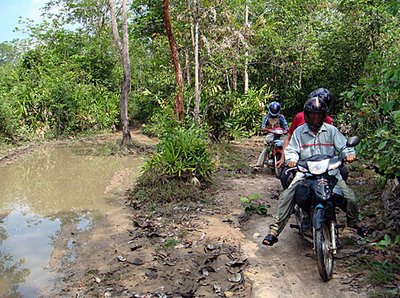 Much of the forest route we took was flooded
Much of the forest route we took was flooded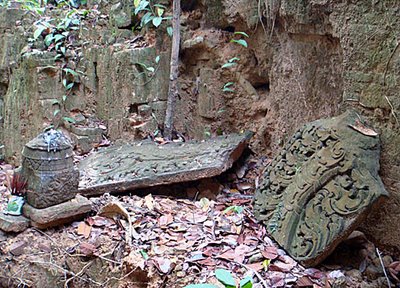 Some of the carving housed in the northern tower of Prasat Trapeang Preus
Some of the carving housed in the northern tower of Prasat Trapeang PreusI didn’t get a good vibe from Snang An, a village of newly-constructed houses doubling up as shops, smiles were absent, the faces weren’t welcoming and the residents, drawn to the area to dig for gold, emitted an undercurrent of hostility I’ve not encountered before. As it was late in the day, Cristiano located a couple of guides in Yot and Tet to take us to the temple nearby, Prasat Kamnap Neang Poav. The forest track took us past a second stone monolith, Kamnap Sre Ar, to the temple site (at N13degrees 02’30.7 and E105degrees 37’23.2) which was basically a hump of ground, covered in debris from the brick temple that once stood there with a large hole in the ground at its centre. It’s located six kilometres from the village, where our accommodation for the night was the open shop-front of Tet’s house.
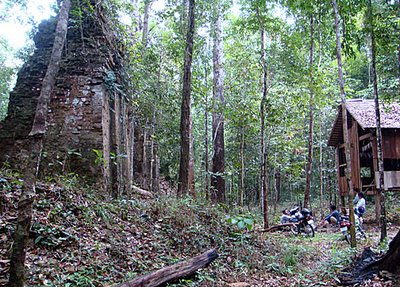 The forest setting of Prasat Trapeang Preus, with our party and spirit house on the right
The forest setting of Prasat Trapeang Preus, with our party and spirit house on the right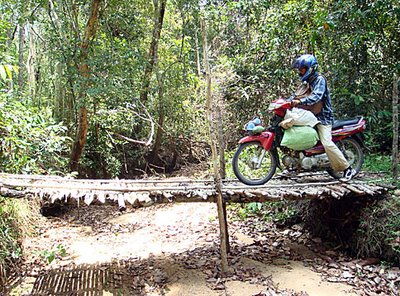 Crossing a small bridge above a dried-out riverbed
Crossing a small bridge above a dried-out riverbed
In three tough hours (and forty kilometres), we were sat eating lunch at Tumring market. We said our goodbyes to Chhoun and Srey Nee who’d been great company, fixed a flat tyre and decided against taking an alternate route back to Kompong Thom via Sandan when the locals advised that it was flooded and impassable. So for the next five hours we retraced our steps back to Kompong Thom, stopping along the way for sugar cane juice and petrol, arriving at Cristiano’s home on the outskirts of the city at 5.30pm. Our Phnom Chi trip was at an end, two temples had been visited, lots of new friends made and some very tough terrain conquered, and whilst it wasn’t as successful, temple-wise, as I’d hoped, it was an enjoyable adventure nonetheless.
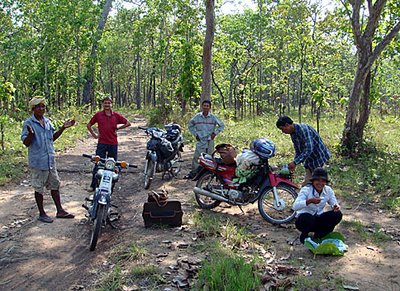 Time for a break and some chicken leftovers en route to Snang An
Time for a break and some chicken leftovers en route to Snang An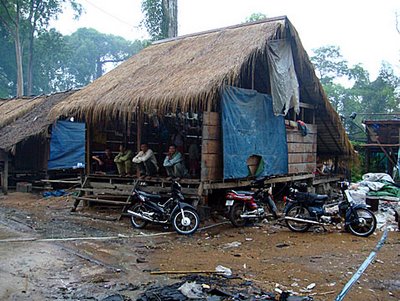 Our overnight accommodation in Snang An, the expensive shop-home of Tet
Our overnight accommodation in Snang An, the expensive shop-home of Tet








1 Comments:
Gold-mining sites and villages are the same everywhere. I'd been to one in Brazil and felt exactly like you - actually the only place in that beautiful land where I sensed hostility and greed in the air. As I've read afterwards, Brazilian Indians, when they seized boats full with gold, made it a point to turn them upside down, claiming gold was the 'God of the whites'... - Terry
Post a Comment
<< Home